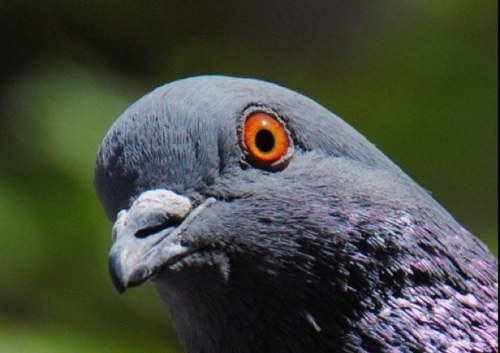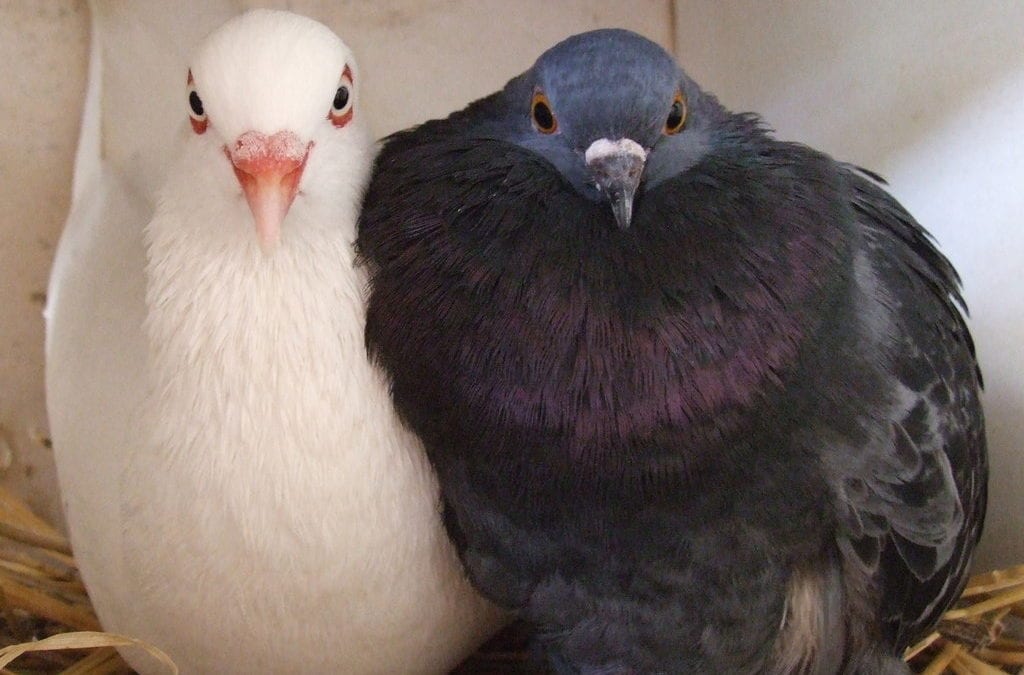
by Pigeon Patrol | Nov 4, 2020 | Columbidae, Doves, Pigeon Control, Pigeons, Pigeons in the News
Looking to learn the differences between pigeons and doves?
Well, look no further, because you’re in the right place!
In this blog you’ll learn:
- Size and Appearance of Doves and Pigeons
- Are Doves and Pigeons Considered Pests?
- Cultural Significance of Doves and Pigeons
- Pest Control for Pigeons
- FAQ
What Are Their Differences In Size And Appearance?
Doves and pigeons are both members of the family of birds known as Columbidae. They are similar in many respects, but there are still some noticeable differences between them.
Doves
Doves are smaller than pigeons. Some weigh as little as 22 grams (less than an ounce). The most noticeable aspect about them is their pointed tail.
The most plentiful breed of doves in America is the mourning dove or rain dove. They typically range in size around 12-inches in length and weigh between 4 and 6 ounces.
The head is rounded with a distinctive crescent-shaped area of dark feathers under each eye. They are a light grayish-brown color with lighter, pink coloration underneath, and a dark speckling on their wings.
They are strong fliers, capable of reaching speeds up to 55 mph. At takeoff and landing their wings make an unusual whistling sound, a phenomena known as sonation, the deliberate production of sounds without using the throat or vocal cords.
The adult males have some bright purple-pink patches on the sides of their neck, along with light pink coloring reaching the breast. On the crown of their head is distinctly bluish-grey in color.
The female, by contrast, is a bit smaller than the males and instead of the male’s bright plumage have more brown coloration overall.
Doves eat seeds almost exclusively and prefer open or semi-open habitats such as prairies, grasslands, and lightly wooded areas while avoiding swamps and thick forests.
They are generally monogamous and both parents participate in feeding and caring for their young. After a noisy courtship flight, the male will lead the female to several potential nesting sites in various trees until she chooses one, then helps her build the nest.
She normally lays two eggs and one or the other of them always remains with the eggs, then later with the young until they’re mature.
Doves will put on a broken-wing display in order to distract a predator who is approaching the nest and their young. They do this by fluttering about on the ground as if they’re helpless or injured, then flying away when the predator gets close.
Pigeons
Pigeons are larger than doves and have a rounded tail instead of a pointed one. They are usually 13-inches or more in length and can weigh as much as 4kg (8.8 pounds).
The most common variety of pigeons are the rock pigeons. They’re usually light gray on their upper body and belly, with a darker gray on their head and breast.
They can be identified by the distinctive iridescent purple and green coloration on their neck and breast. They’re not native to the United States. They were introduced into America from Europe in the 1600’s. This means they have no natural predators to limit their population.
Homing pigeons were selectively bred from rock pigeons to take advantage of their innate ability to find their way home over incredibly long distances. This ability is believed to be a function of magnetoreception, the ability to use the earth’s magnetic field to navigate.
Their long-distance flight speed (over distances of 400 miles) has been clocked at 50 mph sustained speed, but they can go as high as 90 mph in racing contests.
Rock pigeons have been domesticated for thousands of years, as food and as message carriers. The males are usually larger than the females and stand taller.
They have larger beaks, with eye cores (fleshy growth around the eyes), round heads and thick napes. Females, however, are shorter with smaller beaks and ceres. They have flatter heads and larger breasts than the males.
Courtship rituals are noisy. The male will puff out his chest, strut around the female bobbing his head and cooing insistently.
He will often turn completely around during his display. Once the female accepts him, they mate for life and will often re-enact their courtship over and over throughout their lives.
Pigeons are quite content to nest on building ledges, rooftops, girders, and the rafters of warehouses. They eat seeds almost exclusively and will take turns foraging when they have young in their nest.
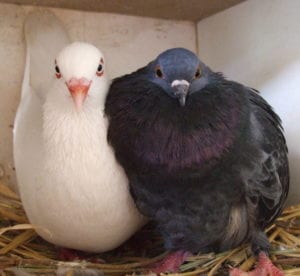
Source
Are Doves and Pigeons Considered Pests?
Yes & No.
Doves aren’t considered pests. They generally don’t nest in and around human habitations, although they have been known to do so occasionally.
For the most part, they are considered a game bird and sportsmen enjoy a good dove hunt as much as hunting for turkeys, pheasants, or any other wild game.
When it comes to pigeons, however, the situation is a bit different. Factories often have quite extensive problems with them nesting in the rafters of warehouses or the upper stories of a power plant.
It doesn’t take long before their population expands to the point where they become a genuine nuisance.
Their droppings discolor machinery, stairways, railings, pallets, crates, and anything else (or anyone else) unfortunate enough to be under when they “let go.” It leaves a pungent, unpleasant odor and the biochemicals in it can accelerate the deterioration of whatever it touches.
What Is The Cultural Significance of Doves and Pigeons?
Doves
For most of human history, doves have been considered symbols of peace. The iconic symbol of a dove carrying an olive branch in its mouth had its beginnings in the early chapters of the Book of Genesis in the Bible.
And he waited yet another seven days, and again he sent the dove out from the ark. Then the dove came to him in the evening, and behold, a freshly plucked olive leaf was in her mouth; and Noah knew that the waters had receded from the earth. [Genesis 8:10-11, NKJV]After the rain stopped, Noah sent out a dove but it came back. The next time he sent it out it came back carrying an olive branch in its beak, a symbol that God’s wrath – and the waters of the Flood – was abating, and peace was returning to the world.
The New Testament also has a dove that symbolizes peace and love. When Jesus went down to the Jordan river to be baptized by John, He came up out of the water and the Holy Spirit, in the shape of a dove, came down upon Him.
When He had been baptized, Jesus came up immediately from the water; and behold, the heavens were opened to Him, and He saw the Spirit of God descending like a dove and alighting upon Him. And suddenly a voice came from heaven, saying, “This is My beloved Son, in whom I am well pleased.” [Matthew 3:16-17, NKJV]That powerful imagery from these two events has stayed with us ever since and has been used in peace movements all over the world even by those who reject the Biblical story of the Flood and Jesus.
There is even a book entitled Doves and Diplomats that is dedicated to the subject.
Pigeons
Despite their many similarities, pigeons occupy a somewhat lower position in the, ahem, pecking order, than doves do. There are Mesopotamian cuneiform tablets that are over 5000 years old showing pigeons being domesticated and raised for food.
They have also been used in commerce, and by the military, to carry important messages back and forth. Early references to pigeons being used to carry messages date back to 2500 B.C.
The Roman Empire used pigeons for this purpose, as did the ancient Greeks. Whereas doves are seen more like symbols, pigeons are more often viewed as work animals or food.
Pigeons have often been housed in structures referred to as dovecotes, essentially a hen house for pigeons. These birdhouses ranged from crude, thatch-covered huts to clay pot-shaped buildings to ornate structures designed to hold thousands of birds.
Pigeons were domesticated not only for food and for its ability to “return home” but also for sport.
Pigeon racing has a long and storied history, as do various forms of falconry and pigeon killing. With the advent of guns, sports shooting of pigeons quickly gained popularity.
Huge numbers of pigeons would be captured, then released all at once in front of a crowd of hunters who shot them at point-blank range.
“Clay pigeons” were derived from this practice when the availability of live pigeons dwindled through over-hunting.
How Can You Control Pigeons?
Doves don’t provide nearly the nuisance level of activity that their larger pigeon cousins do, so this section will focus mainly on pigeons.
As stated earlier, they have a regrettable habit of infesting factories and large buildings then pooping all over them, producing an unsightly mess and a health hazard.
One of the ways PCO’s (Pest Control Operators) defend against pigeons is with the use of anti-bird spikes. Many of them are actually called pigeon control spikes, which tells you how often they’re the culprit in these situations.
These spikes can be laid out on girders and ledges where pigeons like to nest. They can’t land without getting stabbed or hurting their feet so they eventually give up and fly away somewhere else.
A second way PCO’s control pigeon populations is through live trapping. Bird traps are set out with bait corn in them and the doors wired open so they won’t close.
After the pigeons get used the traps and get used to going in and out without harm, then the PCO unwires the doors and lets the traps capture the pigeons. Once the trap is full the PCO collects the birds and transports them away for release back into the wild.
The problem here is obvious; pigeons, with their natural homing ability, quickly return to their “home” in the factory or warehouse and you’re right back to square one.

The only permanent solution is to kill them with poisoned bait. The PCO does essentially the same thing as before with the live trapping, only this time without a trap.
Unpoisoned bait is put out for a week or so to acclimate the birds to being feed at a certain place. Once they’re feeding freely on the safe bait, the poisoned bait is substituted and the pigeons will go on eating it as usual. Very quickly they’ll all be dead.
Frequently Asked Questions
Is it safe to ship doves across the country for a wedding release?
Yes. Dove release companies do this all the time without any danger to the birds. Once released, the birds immediately fly back home again.
What should I do if I find an injured dove or pigeon?
As with any wild animal that is injured, be careful not to let them bite or scratch you. They’re in scared and in pain.
They won’t understand that you’re trying to help them and will fight to escape. Contact a local veterinarian for help on capturing the bird.
Is it okay to feed pigeons and doves?
Yes and no. It’s not illegal to feed them, but you’ll definitely be encouraging them to gather for a daily feeding, which increases the amount of bird poop in the area.
They can also get quite noisy when they’re squabbling over food, which might upset your neighbors. It might not be against the law to feed them, but it might be against good manners.
What should I feed pigeons and doves?
Birdseed for doves and pigeons is available in 6-25 pound bags. Rather than putting it in a bird feeder as people do with smaller birds, spread it out across your backyard.
If you feed them at the same time every day it won’t be long before they’ll be out there waiting for you when it’s time.
About Pigeon Patrol:
Pigeon Patrol Products & Services is the leading manufacturer and distributor of bird deterrent (control) products in Canada. Pigeon Patrol products have solved pest bird problems in industrial, commercial, and residential settings since 2000, by using safe and humane bird deterrents with only bird and animal friendly solutions. At Pigeon Patrol, we manufacture and offer a variety of bird deterrents, ranging from Ultra-flex Bird Spikes with UV protection, Bird Netting, 4-S Gel and the best Ultrasonic and audible sound devices on the market today.
Contact us at 1- 877– 4– NO-BIRD, (604) 585-9279 or visit our website at www.pigeonpatrol.ca
Bird Gone, Pigeon Gone, Seagull Gone, Pigeon problems, 1-877-4NO-BIRD, 4-S Gel, Bird Control, Pigeon Control, bird repellent,, sonic bird repellent, stainless steel , bird spikes Vancouver, Ultra Sonic Bird Control, Bird Netting, Canada bird deterrents, Pigeon Pests, B Gone Pigeon, Pigeon Patrol, pest controller, pest control operator, pest control technician, Pigeon Control Products, humane pigeon, pigeon deterrents, pigeon traps, Pigeon repellents, Sound & Laser Deterrents, wildlife control, raccoon, skunk, squirrel deterrent, De-Fence Spikes, Dragons Den, Canada bird spikes, Canada pigeon, pigeon control, pigeon patrol, pigeon. Kill pigeons, crow, starling, Pigeon Habitat, Pigeon identifications,
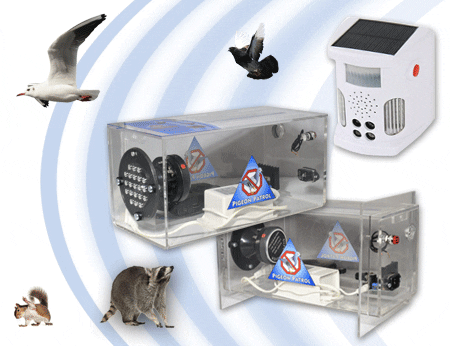
by Pigeon Patrol | Nov 2, 2020 | Animal Deterrent Products, Bird Deterrent Products
What Is It?
Well, What is a UltraSonic Pest Repeller? They are electronic devices that emit high-frequency sounds designed to deter birds, rodents and insects away from your property. Pigeon Patrol has made our own device where the sound is too high pitched for people to hear, but audible to birds. This has the advantage to preventing disturbance to neighboring households. Our device will not a disturbance to house pets such as cats and dogs
How It Works
The ultrasonic devices are placed where you need it the most which may be your balcony or patio which then purportedly emit high-frequency sounds that are disruptive to pests. The sound supposedly causes a physiological response known as audiogenic seizure response, which is characterized by non-directional running, convulsions, and possibly death from cerebral hemorrhage. The theory behind the devices is that confused rodents eventually flee when the disruption prevents them from gathering food, breeding, building nests or communicating. Ultrasonic devices are popular and appealing to consumers because of their ease of use and the fact that they are silent to human ears and allegedly eliminate the need for traps and poison, which are thought by some to be inhumane forms of pest control. Electromagnetic and subsonic devices are also available, and all designs vary by signal intensity, rate and frequency. source
Distress call or sound emitters consist of a central unit and Tweeter. the system emits the distress calls, or calls of predators of the target species. Effective emitters randomize the type of call, time interval and magnitude to prevent birds’ from getting used to the sound.
Contact Us For Any Questions!
(604) 585-9279
About Pigeon Patrol:
Pigeon Patrol Products & Services is the leading manufacturer and distributor of bird deterrent (control) products in Canada. Pigeon Patrol products have solved pest bird problems in industrial, commercial, and residential settings since 2000, by using safe and humane bird deterrents with only bird and animal friendly solutions. At Pigeon Patrol, we manufacture and offer a variety of bird deterrents, ranging from Ultra-flex Bird Spikes with UV protection, Bird Netting, 4-S Gel and the best Ultrasonic and audible sound devices on the market today.
Contact us at 1- 877– 4– NO-BIRD, (604) 585-9279 or visit our website at www.pigeonpatrol.ca
Bird Gone, Pigeon Gone, Seagull Gone, Pigeon problems, pigeon spikes, 1-877-4NO-BIRD, 4-S Gel, Bird Control, Pigeon Control, bird repellent, Bird Spikes, sonic bird repellent, stainless steel bird spikes, bird spikes Vancouver, Ultra Sonic Bird Control, Bird Netting, Plastic Bird Spikes, Canada bird spike deterrents, Pigeon Pests, B Gone Pigeon, Pigeon Patrol, pest controller, pest control operator, pest control technician, Pigeon Control Products, humane pigeon spikes, pigeon deterrents, pigeon traps, Pigeon repellents, Sound & Laser Deterrents, wildlife control, raccoon, skunk, squirrel deterrent, De-Fence Spikes, Dragons Den, Canada bird spikes, Canada pigeon, pigeon control, pigeon patrol, pigeon. Kill pigeons, crow, starling, Pigeon Habitat, Pigeon identifications, Pigeon Spikes, Ultrasonic Pest Repellers
The post What’s The Deal With UltraSonic Pest Repellers? appeared first on Pigeon Patrol Canada – Bird Control Products & Services.
Filed Under: Animal Deterrent Products, Bird Deterrent Products, Pigeon Patrol’s Services, Pigeons in the News, UltraSonic Bird Control
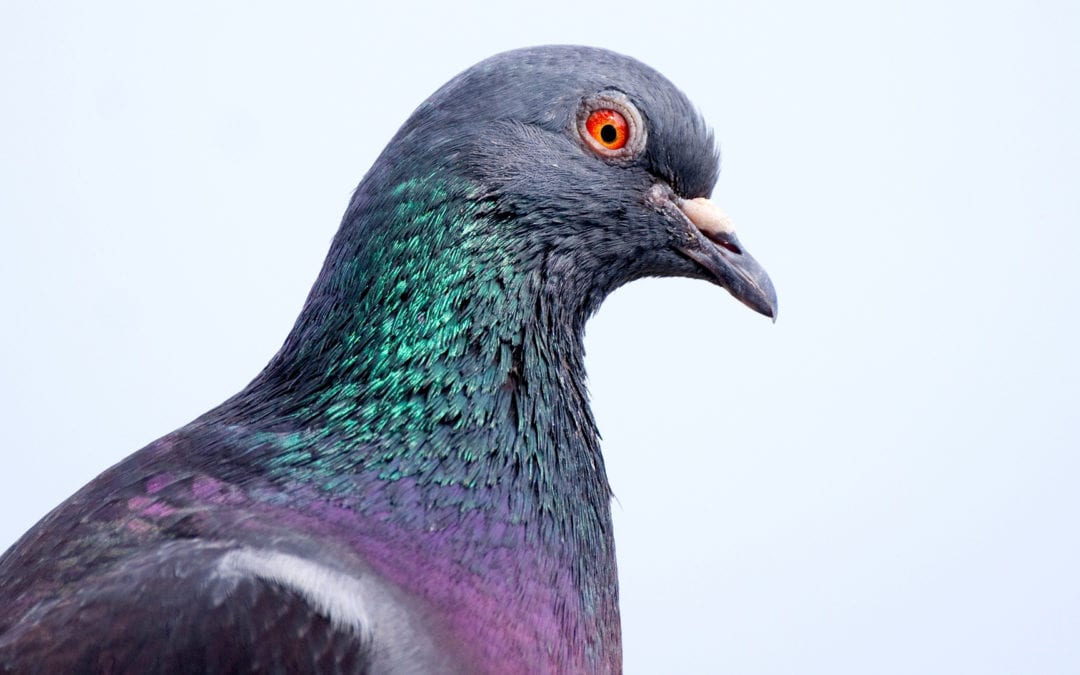
by Pigeon Patrol | Nov 2, 2020 | Pigeon Control, Pigeon Patrol's Services
Pigeon Prevention Methods & Damage Control
Habitat Modification
Some solutions include elimination of feeding, watering, roosting, and nesting sites is important in long-term pigeon control. Discourage people from feeding pigeons in public areas and clean up spilled grain around elevators, feed mills, and rail-car clean-out areas. Eliminate pools of standing water that pigeons use for watering. Modify structures, buildings, and architectural designs to make them less attractive to pigeons.
Exclusion
Pigeons can be excluded from buildings by blocking access to indoor roosts and nesting areas. Openings to lofts, steeples, vents, and eaves should be blocked with wood, metal, glass, rust-proofed wire mesh, plastic or nylon netting with spikes surround it.
Roosting on ledges can be discouraged by changing the angle to 45o or more. Sheet metal, wood, styrofoam blocks, stone, and other materials can be formed and fastened to ledges to accomplish the desired angle. Ornamental architecture can be screened with 1-inch (2.5-cm) mesh polypropylene u.v.-stabilized netting to prevent roosting, loafing, and nesting. To make the netting aesthetically pleasing, it can be spray painted to match the color of the building, but black is often the best choice. The life span of this netting can be as long as 10 years.
In a tool or machinery shed, barn, hangar, or other similar buildings, roosting can be permanently prevented by screening the underside of the rafter area with netting. Nylon netting can be stapled or otherwise affixed to the underside of rafters to exclude birds from nesting and roosting. Panels can be cut into the netting and velcro fasteners can allow access to the rafter area to service equipment or lights.
Porcupine wires are mechanical repellents that can be used to exclude pigeons. They are composed of a myriad of spring-tempered nickel stainless steel prongs with sharp points extending outward at all angles. The sharp points of these wires inflict temporary discomfort and deter pigeons from landing on these surfaces. The prongs are fastened to a solid base that can be installed on window sills, ledges, eaves, roof peaks, ornamental architecture, or wherever pigeons are prone to roost (Fig. 2). Elevate the base with plastic washers and anchor it with electrical bundle straps. Sometimes pigeons and sparrows cover the wires with nesting material or droppings, which requires occasional removal.
A variation of porcupine wires, ECOPICTM, mounts flat to a surface and has a triangular pattern of vertically oriented stainless steel rods.
Bird BarrierTM is another permanent nonlethal mechanical repellent used to exclude pigeons from structures. It is a stainless steel coil affixed to a base-mounting strip that can be attached to structural features as one would with porcupine wires.
Tightly stretched parallel strands of 16-to 18-gauge steel wire or 80-pound+ (36-kg+) test monofilament line can be used to keep birds off support cables, narrow ledges, conduit, and similar areas. Attach L-brackets at each end of the area or item to be protected and fasten the wire to the L-brackets with turnbuckles. Slack is taken out using the turnbuckles. L-brackets should be welded or attached with a cable clamp or aircraft hose clamps (threads on standard radiator clamps become stripped under the high torque loads required for holding L-brackets sup-porting wire over long distances). On heavily used structures, it may be necessary to stretch 3 lines at 2, 5, and 7 inches (5, 12, and 18 cm) above the surface.
Overhead monofilament grid systems, 1 x 1 foot to 2 x 2 feet (30 x 30 cm to 60 x 60 cm), have been used success-fully to reducing pigeon activity in en-closed courtyards. Persistent pigeons will likely penetrate parallel or grid-wire (line) systems.
Electric shock bird control systems (Avi-AwayTM, FlyawayTM, and Vertebrate Repellent System [VRSTM]) are available for repelling many species of birds, including pigeons. The systems consist of a cable durably embedded in plastic with two electrical conductors. Mounting and grounding hardware and a control unit are included. The conductors carry a pulsating electric charge. When pigeons make contact with the conductors and the cable, they receive a shock that repels but does not kill them. The cable can be in-stalled in situations also suitable for porcupine wires and stretched steel wires or monofilament lines. Although these devices and their installation are usually labor intensive and/or expensive, their effectiveness in some cases justifies the investment. These devices have a life span of 8 years on residential structures.
other control methods include:
Frightening
- Propane cannons
- Distress calls
- Mylar-style tape
- Scare-eye balloons
- Long-range acoustic devices
- Avitrol®
Repellents
- Polybutenes and capsaicin-based products
- Methyl anthranilate
Toxicants
Shooting
- .177-caliber pellet guns
- .22-caliber rifles
- Shotgun with No. 7½ shot
Trapping
- Multiple capture cage traps
- Single-bird traps
- Cannon nets
- Hand-held nets
- Mist netting
Other Control Methods
Source
Contact Us For Any Questions!
(604) 585-9279
About Pigeon Patrol:
Pigeon Patrol Products & Services is the leading manufacturer and distributor of bird deterrent (control) products in Canada. Pigeon Patrol products have solved pest bird problems in industrial, commercial, and residential settings since 2000, by using safe and humane bird deterrents with only bird and animal friendly solutions. At Pigeon Patrol, we manufacture and offer a variety of bird deterrents, ranging from Ultra-flex Bird Spikes with UV protection, Bird Netting, 4-S Gel and the best Ultrasonic and audible sound devices on the market today.
Contact us at 1- 877– 4– NO-BIRD, (604) 585-9279 or visit our website at www.pigeonpatrol.ca
Bird Gone, Pigeon Gone, Seagull Gone, Pigeon prevention methodsPigeon problems, pigeon spikes, 1-877-4NO-BIRD, 4-S Gel, Bird Control, Pigeon Control, bird repellent, Bird Spikes, sonic bird repellent, stainless steel bird spikes, bird spikes Vancouver, Ultra Sonic Bird Control, Bird Netting, Plastic Bird Spikes, Canada bird spike deterrents, Pigeon Pests, B Gone Pigeon, Pigeon Patrol, pest controller, pest control operator, pest control technician, Pigeon Control Products, humane pigeon spikes, pigeon deterrents, pigeon traps, Pigeon repellents, Sound & Laser Deterrents, wildlife control, raccoon, skunk, squirrel deterrent, De-Fence Spikes, Canada bird spikes, Canada pigeon, pigeon control, pigeon patrol, pigeon. Kill pigeons, crow, starling, Pigeon Habitat, Pigeon identifications, Pigeon Spikes, Ultrasonic Pest Repellers, Pest Control, Bird Spike Installation, Netting Installation, Pigeon Prevention Methods & Damage Control, Bird netting,
The post Pigeon Prevention Methods & Damage Control appeared first on Pigeon Patrol Canada – Bird Control Products & Services.
Filed Under: 4-S Gel Bird repellent, Animal Deterrent Products, Bird Deterrent Products, Bird Netting, Pigeon Patrol’s Services, Pigeon Spikes, UltraSonic Bird Control

by Pigeon Patrol | Nov 2, 2020 | history of pigeons
Where Are They Found?
The history of these pigeons were originally found wild in Europe, North Africa, and Western Asia, pigeons have become established in cities around the world. The species is abundant, with an estimated population of 17 to 28 million feral and wild birds in Europe alone and up to 120 million worldwide. These birds were introduced into North America in the early 1600’s. Window ledges and tall buildings mimic the rocky cliffs originally inhabited by their ancient ancestors in Europe. The pigeon has a long history of association with humans, having been used for food and entertainment for over 5,000 years. Source
How Many Species Are There?
Pigeons live worldwide except in the coldest regions and the most remote islands. About 250 species are known; two-thirds of them occur in tropical Southeast Asia, Australia, and the islands of the western Pacific, but the family also has many members in Africa and South America and a few in temperate Eurasia and North America. All members of the family suck liquids, rather than sip and swallow as do other birds, and all pigeon parents feed their young “pigeon’s milk,” the sloughed-off lining of the crop, the production of which is stimulated by the hormone prolactin. The nestling obtains this “milk” by poking its bill down the parent’s throat.
Pigeons are gentle, plump, small-billed birds with a skin saddle (cere) between the bill and forehead. All pigeons strut about with a characteristic bobbing of the head. Because of their long wings and powerful flight muscles, they are strong, swift fliers. Pigeons are monogamous; i.e., they mate for life, and the survivor accepts a new mate only slowly. The female lays two glossy white eggs in a flimsy nest that barely holds them. The female generally incubates the eggs by night, the male by day. The incubation period is 14 to 19 days, but the young are cared for in the nest for another 12 to 18 days. Source
Contact Us For Any Questions!
(604) 585-9279
About Pigeon Patrol:
Pigeon Patrol Products & Services is the leading manufacturer and distributor of bird deterrent (control) products in Canada. Pigeon Patrol products have solved pest bird problems in industrial, commercial, and residential settings since 2000, by using safe and humane bird deterrents with only bird and animal friendly solutions. At Pigeon Patrol, we manufacture and offer a variety of bird deterrents, ranging from Ultra-flex Bird Spikes with UV protection, Bird Netting, 4-S Gel and the best Ultrasonic and audible sound devices on the market today.
Contact us at 1- 877– 4– NO-BIRD, (604) 585-9279 or visit our website at www.pigeonpatrol.ca
Bird Gone, Pigeon Gone, Seagull Gone, Pigeon problems, pigeon spikes, 1-877-4NO-BIRD, 4-S Gel, Bird Control, Pigeon Control, bird repellent, Bird Spikes, sonic bird repellent, stainless steel bird spikes, bird spikes Vancouver, Ultra Sonic Bird Control, Bird Netting, Plastic Bird Spikes, Canada bird spike deterrents, Pigeon Pests, B Gone Pigeon, Pigeon Patrol, pest controller, pest control operator, pest control technician, Pigeon Control Products, humane pigeon spikes, History of pigeons, pigeon deterrents, pigeon traps, Pigeon repellents, Sound & Laser Deterrents, wildlife control, raccoon, skunk, squirrel deterrent, De-Fence Spikes, Dragons Den, Canada bird spikes, Canada pigeon, pigeon control, pigeon patrol, pigeon. Kill pigeons, crow, starling, Pigeon Habitat, Pigeon identifications, Pigeon Spikes, Ultrasonic Pest Repellers
The post History of Pigeons appeared first on Pigeon Patrol Canada – Bird Control Products & Services.
Filed Under: Pigeon Patrol’s Services
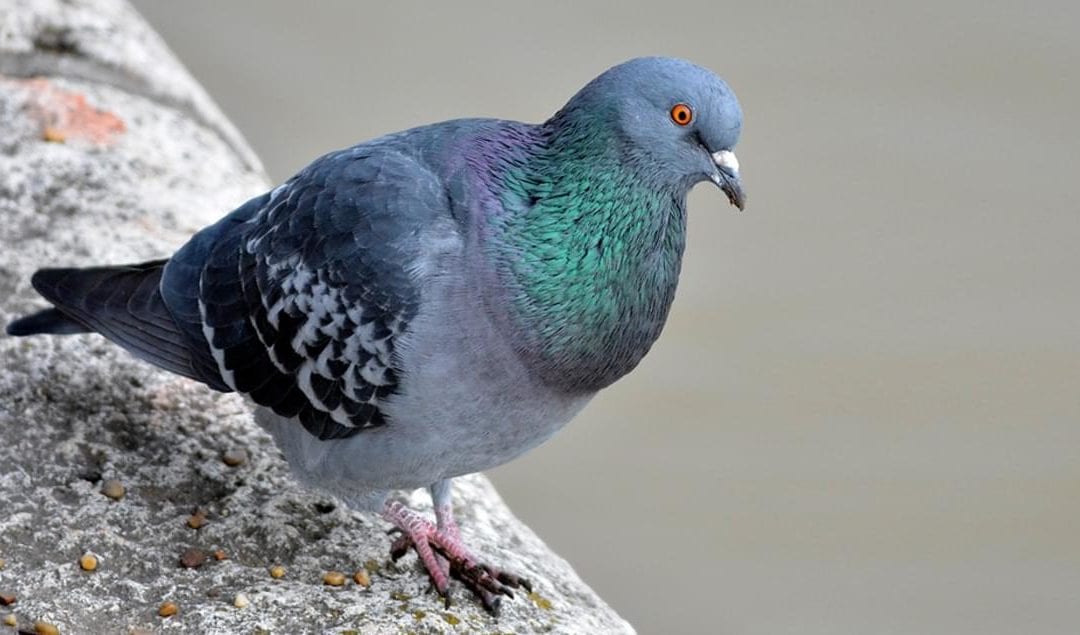
by Pigeon Patrol | Oct 26, 2020 | Animal Deterrent Products, Bird Deterrent Products, Bird Netting, Bird Spikes, Pigeon Control, Pigeon Spikes
What To Do With Annoying Pigeons
When pigeon flocks grow too large, use these humane methods to control their numbers
From a pigeon’s perspective, city living can’t be beat. Food and water are readily available. Predators are rare. Plus, there’s plenty of free housing. Pigeons find our window ledges, rooftops, bridges, and warehouses to be ideal substitutes for the natural ledges in cliff sides that they have always used as roosting, nesting, and sheltering sites.
Steps to Solve Pigeon Problems
You may just need one or a combination of all techniques, depending on the size of the pigeon population you’re dealing with.
Spikes & Nettings
The bird spike is a simple device used to prevent birds from perching or roosting on flat surfaces. Spike systems consist of thin, mildly flexible rods set in a base in multiple rows at varying angles. Pigeon spikes are not sharp and will not harm birds in any way; pigeon spikes are always dull and are completely safe and humane. Contact with the spikes is uncomfortable but never painful or dangerous. The sole purpose of the spikes is to block the birds’ feet from reaching the flat surface; without a foothold, the birds can’t roost. You can use bird spikes to protect your property with a clear conscience.
Bird control spikes are easy to understand, install, and maintain. No special tools are needed, no complicated assembly is involved, and making certain that the spikes don’t become clogged with leaves or other debris is the only maintenance required. In addition, no other bird control device is as cost-effective when measured in money and time; anti-bird spikes don’t require costly installation upfront and continue to function for a long, long time. Bird spikes are honestly a great way to keep birds away.
Anti-bird spikes offer the following advantages:
They Are Safe
Impaling birds is not the purpose of the spikes. Bird spikes have harmless, dull tips, and the spikes themselves are just a bit bendy. When birds try to land, they get a gentle, uncomfortable prod in their undercarriage, and their feet are unable to reach the surface.
Effective
Many bird control experts agree that bird spikes are 100% effective at deterring roosting birds when installed correctly. Spikes work by preventing birds from roosting, and they work every time. Rain or shine, day or night, today, tomorrow, and next year, spikes keep birds away.
Long Lifetime
Bird control spikes offer low-maintenance protection for years. High-quality strips and spikes are constructed to withstand constant exposure to harsh, changing weather conditions.
Unobstructive
Strips don’t cause any interference with electrical or communication transmissions, and, especially from a distance, they won’t significantly interfere with the look of your property. The only thing you will notice is the absence of birds.
Easy To Use
Spikes come preassembled in 2-foot strips that are notched for a tool-free breakdown. A piped line of adhesive down the bottom of the strip gives you a quick and permanent installation, or, for temporary installation, strips can be nailed, screwed, or even zip-tied down. Plus, anyone can do it; installing bird spikes is well within the skills of any competent DIYer.
Stop Feeding The Pigeons (intentionally or not)
Most conflicts with pigeons can be tied at one point or another to feeding, intentionally or otherwise.
Pigeons get fed plenty of handouts and garbage, but there are also well-intentioned pigeon lovers who regularly feed the birds. This does the pigeons more harm than good as the pigeons begin to gather in large numbers, often leading to inhumane and ineffective attempts to reduce their numbers.
When such troubles arise, the best thing for the birds is to reduce feeding gradually over several weeks. The flock will gradually disperse until the remaining number of birds matches what the area can naturally support.
Unintentional Food Sources
Even when not feeding on purpose, we humans are messy, leaving leftovers and dropped crumbs everywhere. Pigeons hang around town squares, public parks, and other trafficked areas to help themselves to what we leave behind, especially when convenient roosting and nesting sites are nearby. To discourage pigeons from gathering, food attractants need to be cleaned up regularly.
In suburban neighborhoods, too, homeowners may mistakenly feed pigeons or they may be providing food for pigeons inadvertently when feeding their backyard birds by tossing seed on the ground, rather than putting it in birdfeeders. To discourage pigeons visiting your yard, change the type, amount, and timing of feeding. If most of the pigeons fail to move elsewhere, you’ll need to stop feeding all birds for a couple weeks. (Don’t worry; the birds won’t starve.) When you resume feeding, only put out seed in birdfeeders and keep the ground below them cleaned up.
Prevent Roosting and Nesting
Pigeons look for flat surfaces for roosting and nesting. Encourage them to do these things elsewhere by making flat surfaces unavailable to them. With the correct application of the right product, roosting structures can be rendered virtually pigeon-free.
Follow these tips and steps to get rid of the annoying pigeons
source
About Pigeon Patrol:
Pigeon Patrol Products & Services is the leading manufacturer and distributor of bird deterrent (control) products in Canada. Pigeon Patrol products have solved pest bird problems in industrial, commercial, and residential settings since 2000, by using safe and humane bird deterrents with only bird and animal friendly solutions. At Pigeon Patrol, we manufacture and offer a variety of bird deterrents, ranging from Ultra-flex Bird Spikes with UV protection, Bird Netting, 4-S Gel and the best Ultrasonic and audible sound devices on the market today.
Contact us at 1- 877– 4– NO-BIRD, (604) 585-9279 or visit our website at www.pigeonpatrol.ca
Bird Gone, Pigeon Gone, Seagull Gone, Pigeon problems, pigeon spikes, 1-877-4NO-BIRD, 4-S Gel, Bird Control, Pigeon Control, bird repellent, Bird Spikes, bird law sonic bird repellent, stainless steel bird spikes, bird spikes Vancouver, Ultra Sonic Bird Control, Bird Netting, Plastic Bird Spikes, Canada bird spike deterrents, Pigeon Pests, B Gone Pigeon, annoying pigeons, Pigeon Patrol, annoying pigeons pigeon family pest controller, pest control operator, Bird law pest control technician, Pigeon Control Products, humane pigeon spikes,pigeon droppings pigeon deterrents, type of birds, pigeon traps, Pigeon repellents, Sound & Laser Deterrents, wildlife control, raccoon, skunk, squirrel deterrent, De-Fence Spikes, Dragons Den, Canada bird spikes, Pigeon behavior ,Canada pigeon, pigeon control, pigeon patrol, pigeon. Kill pigeons, crow, starling, Pigeon Habitat, annoying pigeons
